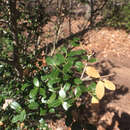Description
(
Inglês
)
fornecido por eFloras
Shrubs evergreen, 5-10 m tall; bark gray-black. Young branchlets gray or black, longitudinally angular, densely pubescent; older branchlets with leaf scars raised lunate, lenticels sparsely elliptic or circular. Stipules subulate, minute; petiole 2-3 mm, sulcate, pubescent; leaf blade abaxially greenish, adaxially green, shiny, obovate, elliptic, or oblong-elliptic, 1-3.5 × 0.5-1.5 cm, leathery, abaxially glabrous, densely brown glandular punctate, adaxially glabrous except on midvein, rugose when dry, midvein adaxially flat or slightly impressed, pubescent, lateral veins 3-5 pairs, obscure, reticulate veins indistinct, base obtuse or cuneate, margin crenate-serrate, apex rounded, obtuse, or subacute. Male inflorescences: cymes of order 1-3, 1-7-flowered, solitary, axillary on scales or lower leaves of current year’s branchlets, rarely pseudofasciculate on second year’s branchlets; peduncles 4-9 mm; secondary axis ca. 1 mm; pedicels 2-3 mm, bracteoles 1 or 2, subbasal; 1-flowered pedicels 4-8 mm, bracteoles 1 or 2, submedian; flowers white, 4-merous; calyx patelliform, ca. 2 mm in diam., glabrous, 4-lobed, lobes broadly deltoid, margin erose; petals 4, broadly elliptic, ca. 2 mm, basally slightly connate; stamens shorter than petals, anthers elliptic; rudimentary ovary conical, apex slightly apiculate or acute. Female inflorescences: cymes of order 1(or 2), 1(-3)-flowered, solitary, axillary on current year’s branchlets; pedicels 3.5-6(-12) mm, distal half slightly thickened, longitudinally ridged; bracteoles 1 or 2, submedian; flowers 4-merous; calyx ca. 3 mm in diam., 4-lobed, lobes rounded; corolla ca. 6 mm in diam., petals ovate, ca. 3 mm, basally slightly connate; staminodes ca. 1/2 as long as petals, sterile anthers sagittate; ovary ovoid, ca. 2 mm, style sometimes distinct, stigma discoid, 4-lobed. Fruit black, globose, 6-8 mm in diam.; fruiting pedicel 4-6 mm; persistent calyx explanate, ca. 3 mm in diam.; persistent stigma thickly discoid, ca. 1 mm in diam., conspicuously 4-lobed; pyrenes 4, oblong-ellipsoidal, ca. 5 mm, 3-3.5 mm in diam., abaxially smooth, striate, not sulcate, endocarp leathery. Fl. May-Jun, fr. Aug-Oct.
- licença
- cc-by-nc-sa-3.0
- direitos autorais
- Missouri Botanical Garden, 4344 Shaw Boulevard, St. Louis, MO, 63110 USA
Distribution
(
Inglês
)
fornecido por eFloras
Anhui, Fujian, Guangdong, Guangxi, Hainan, Hubei, Hunan, Jiangsu, Jiangxi, Taiwan, Shandong (Qingdao), Zhejiang [Japan, Korea].
- licença
- cc-by-nc-sa-3.0
- direitos autorais
- Missouri Botanical Garden, 4344 Shaw Boulevard, St. Louis, MO, 63110 USA
Habitat
(
Inglês
)
fornecido por eFloras
Forests, thickets on hills or mountains; 700-2100 m.
- licença
- cc-by-nc-sa-3.0
- direitos autorais
- Missouri Botanical Garden, 4344 Shaw Boulevard, St. Louis, MO, 63110 USA
Synonym
(
Inglês
)
fornecido por eFloras
Celastrus adenophyllus Miquel; Ilex crenata var. aureovariegata Goldring; Ilex crenata f. bullata Rehder; I. crenata f. helleri (Craig) Rehder; I. crenata var. helleri (Craig) L. H. Bailey; I. crenata f. kusnetzoffii Loesener; I. crenata f. latifolia (Goldring) Rehder; I. crenata var. latifolia Goldring; I. crenata f. longifolia (Goldring) Rehder; I. crenata var. longifolia Goldring; I. crenata f. longipedunculata S. Y. Hu; I. crenata f. luteovariegata (Regel) Rehder; I. crenata var. luteovariegata Regel; I. crenata var. major G. Nicholson ex Dallimore; ?I. crenata var. mariesii Dallimore; I. crenata f. microphylla Rehder; I. crenata f. multicrenata (C. J. Tseng) S. K. Chen; I. crenata var. multicrenata C. J. Tseng; I. crenata f. nummularia (Yatabe) H. Hara; I. crenata var. nummularia Yatabe; ?I. crenata f. variegata G. Nicholson; ?I. crenata var. variegata (G. Nicholson) Dallimore; I. euryifolia K. Mori & Yamamoto; I. helleri Craig.
- licença
- cc-by-nc-sa-3.0
- direitos autorais
- Missouri Botanical Garden, 4344 Shaw Boulevard, St. Louis, MO, 63110 USA
Ilex crenata
(
Inglês
)
fornecido por wikipedia EN
Ilex crenata, the Japanese holly or box-leaved holly (Japanese: イヌツゲ inutsuge) is a species of flowering plant in the family Aquifoliaceae, native to eastern China, Japan, Korea, Taiwan, and Sakhalin.[1]
It is an evergreen shrub or small tree growing to a height of 3–5 m (rarely 10 m) tall, with a trunk diameter up to 20 cm. The leaves are glossy dark green, small, 10–30 mm long and 10–17 mm broad, with a crenate (wavy) margin, sometimes spiny. The plants are dioecious (having separate male and female plants), with white, four-lobed flowers. The fruit is a black drupe (stone fruit) 5 mm diameter, containing four seeds. It grows well in acidic soil, between a pH of 3.7 and 6.0.[2][3][4]
Cultivation

Ilex crenata edging
parterre beds in an English garden
Ilex crenata is grown as an ornamental plant for its dense evergreen foliage, and is a popular plant among bonsai enthusiasts.[5] It is superficially similar in appearance to boxwood (box), and is often used in similar situations, such as low hedging; but it can readily be distinguished from boxwood by its alternate, not opposite, leaf arrangement.
Numerous cultivars have been selected, including plants with the leaves variegated (e.g. 'Golden Gem', 'Shiro-Fukurin'), dark green (e.g. 'Green Lustre'), or greyish-green (e.g. 'Bad Zwischenahn'); with yellow fruit (e.g. 'Ivory Hall'); and with an erect habit (e.g. 'Chesapeake'), spreading (e.g. 'Green Island', 'Hetzii'), or dwarf (e.g. 'Mariesii', 'Stokes').[4] The cultivars 'Golden Gem'[6] and ‘Fastigiata’ (Fastigiata Group)[7] have gained the Royal Horticultural Society's Award of Garden Merit.[8]
References

- licença
- cc-by-sa-3.0
- direitos autorais
- Wikipedia authors and editors
Ilex crenata: Brief Summary
(
Inglês
)
fornecido por wikipedia EN
Ilex crenata, the Japanese holly or box-leaved holly (Japanese: イヌツゲ inutsuge) is a species of flowering plant in the family Aquifoliaceae, native to eastern China, Japan, Korea, Taiwan, and Sakhalin.
It is an evergreen shrub or small tree growing to a height of 3–5 m (rarely 10 m) tall, with a trunk diameter up to 20 cm. The leaves are glossy dark green, small, 10–30 mm long and 10–17 mm broad, with a crenate (wavy) margin, sometimes spiny. The plants are dioecious (having separate male and female plants), with white, four-lobed flowers. The fruit is a black drupe (stone fruit) 5 mm diameter, containing four seeds. It grows well in acidic soil, between a pH of 3.7 and 6.0.

close-up of flowers

close-up of drupes
- licença
- cc-by-sa-3.0
- direitos autorais
- Wikipedia authors and editors




